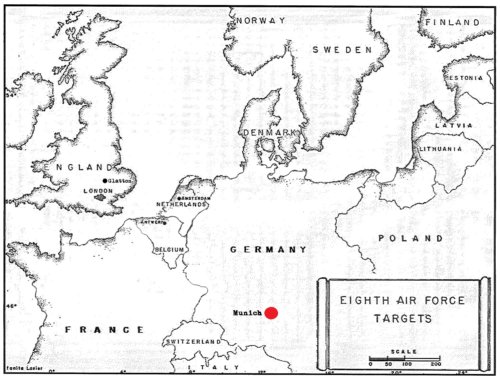TARGET: MARSHALLING YARDS
MUNICH, GERMANY
25 FEBRUARY, 1945

The marshalling yards at Munich were the target. The Group comprised the 94th A Combat Group with Lt. Col. Watson as Air Commander.
The Group was below briefed altitude throughout the route over England because of weather. Deviations to left and right of course were necessary in order to make the first Control Point on time. Combat Wing assembly was not completed until this point because the 35 1st Bomb Group had climbed above the 457th Group’s altitude.
The Group was on course, and in proper position in Division formation. Division assembly line was flown as briefed. Route over the Continent was uneventful. Minor deviations in course were necessary in order to remain in formation. The IF was reached on course.
A visual run was made on the primary target, with each squadron lead aircraft performing its own sighting operation. Cloud coverage was nil with good visibility. The lead squadron identified the MPI about twenty miles from the BRL. Bombs hung up in the lead craft, finally releasing four or five seconds after the salvo switch was thrown. The low squadron bombardier identified the MPI seven miles from the target and a manual run was made. The high squadron identified the MPI about two minutes before the BRI, but experienced some difficulty when the pilot was hit by flak and the ship veered sharply just before bombs away. The run was made on AFCE (Automatic Flight Control Equipment) by both the lead and high squadrons. All squadrons were hindered in the sighting operation by antiaircraft fire. Bombs were dropped from 25,000 feet. Bombing results were fair.
Flak was intense and accurate with twenty-six bombers Sustaining damage. One crew member of Lt John C. Lindholm’s crew, Sgt Robert V. Grunhurd, was killed in action.
